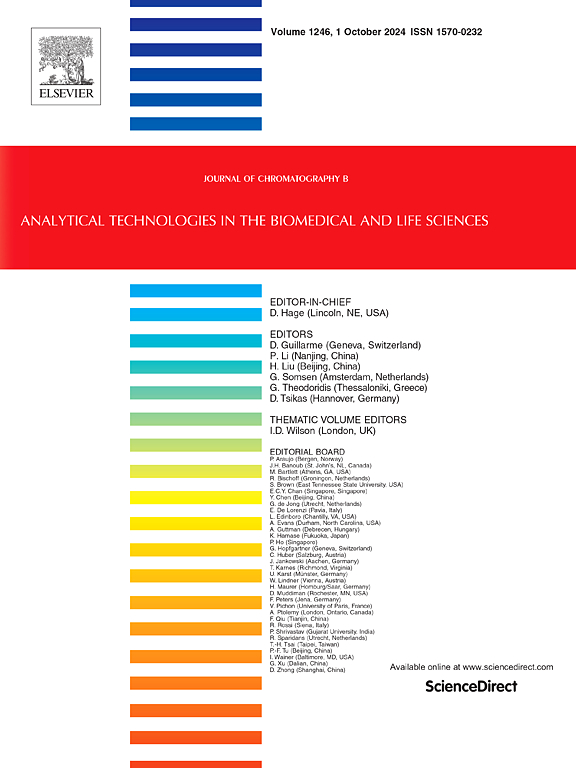利用 UPLC-MS/MS 对大鼠体内果胶苷元的药代动力学和组织分布进行研究。
IF 2.8
3区 医学
Q2 BIOCHEMICAL RESEARCH METHODS
引用次数: 0
摘要
果胶苷元(Pectolinarigenin,PEC)是从日本长春花中分离出来的一种天然黄酮类化合物,具有治疗多种癌症的潜力。本研究建立了一种简便灵敏的 UPLC-MS/MS 方法,用于定量检测大鼠血浆和组织中的 PEC。该方法以他达拉非为内标物,一步沉淀蛋白;采用Welch Xtimate UHPLC C18色谱柱,以乙腈/甲酸水溶液(0.1%,v/v)为流动相进行梯度洗脱,流速为0.2 m L-min-1。在正离子模式下,通过电喷雾离子源进行多重反应监测。该方法灵敏度高,在血浆0.1-100 ng-mL-1和组织1-10,000 ng-mL-1浓度范围内线性关系良好(R2 > 0.99),提取回收率(≥71.17%)、基质效应和稳定性均可接受,可用于研究PEC在静脉注射(100 μg-kg-1)和口服(10、20和40 mg-kg-1)后的药代动力学和组织分布。大鼠口服 PEC 后吸收迅速(Tmax ≤ 0.222 h),并维持在较低水平,消除缓慢(t1/2 z ≥ 14.47 h),因此生物利用度极低(0.56-0.68 %)。不过,PEC 在大鼠组织中分布广泛,在消化道、肝脏和肾脏中的暴露量较高。该研究首次揭示了 PEC 的生物利用度和组织亲和性,为进一步开发 PEC 作为抗肿瘤候选药物指明了方向。本文章由计算机程序翻译,如有差异,请以英文原文为准。
Pharmacokinetic and tissue distribution study of pectolinarigenin in rats using UPLC-MS/MS
Pectolinarigenin (PEC), a natural flavonoid isolated from Cirsium japonicum, exhibits promising therapeutic potential for multiple cancers. In present study, a simple and sensitive UPLC-MS/MS method was established for the quantification of PEC in rat plasma and tissues. The assay procedure involved a one-step protein precipitation with tadalafil as the internal standard, and separation on a Welch Xtimate UHPLC C18 column by gradient elution of acetonitrile/aqueous formic acid (0.1 %, v/v) at a flow rate of 0.2 m L·min−1. The detection was conducted using multiple-reaction monitoring via an electrospray ionization source in positive ionization mode. The established method was proved to be highly sensitive with a good linearity (R2 > 0.99) in respective concentration range (0.1–100 ng·mL−1 in plasma and 1–10,000 ng·mL−1 in tissues) and acceptable extraction recovery (≥71.17 %), matrix effect and stability, which was applied to study the pharmacokinetics and tissue distribution of PEC after intravenous (100 μg·kg−1) and oral administration (10, 20 and 40 mg·kg−1). PEC was promptly absorbed (Tmax ≤ 0.222 h) and maintained at a low level with slow elimination (t1/2 z ≥ 14.47 h) in rats after oral administration, resulting in extremely low bioavailability (0.56–0.68 %). However, PEC is widely distributed in rat tissues with high exposure in GI tract, liver and kidney. The bioavailability and tissue affinity were firstly revealed, which would guide directions for further development of PEC as an anti-tumor drug candidate.
求助全文
通过发布文献求助,成功后即可免费获取论文全文。
去求助
来源期刊

Journal of Chromatography B
医学-分析化学
CiteScore
5.60
自引率
3.30%
发文量
306
审稿时长
44 days
期刊介绍:
The Journal of Chromatography B publishes papers on developments in separation science relevant to biology and biomedical research including both fundamental advances and applications. Analytical techniques which may be considered include the various facets of chromatography, electrophoresis and related methods, affinity and immunoaffinity-based methodologies, hyphenated and other multi-dimensional techniques, and microanalytical approaches. The journal also considers articles reporting developments in sample preparation, detection techniques including mass spectrometry, and data handling and analysis.
Developments related to preparative separations for the isolation and purification of components of biological systems may be published, including chromatographic and electrophoretic methods, affinity separations, field flow fractionation and other preparative approaches.
Applications to the analysis of biological systems and samples will be considered when the analytical science contains a significant element of novelty, e.g. a new approach to the separation of a compound, novel combination of analytical techniques, or significantly improved analytical performance.
 求助内容:
求助内容: 应助结果提醒方式:
应助结果提醒方式:


